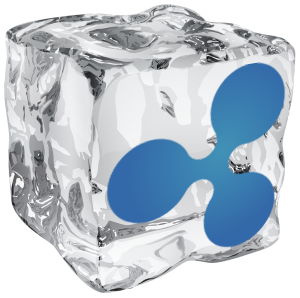The rise of ripple (XRP) over the past eight months has been interesting to many digital asset spectators and the network also has its fair share of controversy. At the moment XRPs are trading at an average of $2.20-2.40 per token and ripple’s total market valuation has captured $91Bn this week. Many skeptics are wondering what’s behind the recent XRP price spike and speculate a big correction could be imminent.
Also Read: Ripple Gains 1,000% in One Month – Now the Second Largest Cryptocurrency
A Database of Validating Nodes Called Ripple Competes With the Blockchain Giants
 Ripple (XRP) is making some serious headway this week as the protocol’s token value has grown exponentially over the past few months. The Ripple network and its parent company, Ripple Labs, considers itself an all-in-one remittance network and currency exchange. The protocol is called a real-time gross settlement system (RTGS) which acts as a distributed ledger between a network of nodes.
Ripple (XRP) is making some serious headway this week as the protocol’s token value has grown exponentially over the past few months. The Ripple network and its parent company, Ripple Labs, considers itself an all-in-one remittance network and currency exchange. The protocol is called a real-time gross settlement system (RTGS) which acts as a distributed ledger between a network of nodes.
These nodes or validating servers do not offer an incentive like the Bitcoin network’s proof-of-work (PoW) as the network is managed by independently owned servers. This has led to accusations that Ripple’s network is extremely centralized because most validating servers are operated by banks, market makers, and Ripple Labs. Financial institutions that have been using Ripple include Earthpoint, Fidor Bank, Bank of America, and HSBC.
No Proof-of-Work Created the Largest Pre-Mine Ever
With no PoW and just a group of validating nodes, all 100 billion XRP tokens were created during the initial launch of the Ripple network. 38 billion of these XRPs are currently in circulation, while the founders of the database and the company took the remainder of the XRP holdings. Skeptics say one of the scariest aspects of ripple markets is the fact that Ripple Labs controls over 60 billion XRP which is more than half of what is currently in circulation.
The Curious Case of Jed McCaleb and the ‘Founders’ Coins’

Ripple was established in 2012 by Ryan Fugger and Jed McCaleb and was initially called Ripplepay. The co-founder Jed McCaleb is well known for also helping Mt Gox get its start with Mark Karpeles. McCaleb at the time rebranded the Ripplepay company to Ripple and helped promote the public database until late 2013. McCaleb then left the company that year to start his own venture called the Stellar network which is basically a fork of XRP’s codebase but a different distribution process. In 2014 XRP markets dropped in value considerably as it was rumored that Jed McCaleb was planning to sell off his shares of 9 Billion XRP. It is still unconfirmed to this day if McCaleb actually followed through with the ripple sale.
Another Ripple founder, Chris Larsen, donated 7 billion XRP to charity roughly around the same timeframe. Then McCaleb appeared in the headlines again as publications ran stories about him trying to sell more of his founding XRP shares on the Bitstamp exchange. Ripple Labs decided that the sale was not in the best interest of the network so the XRPs were frozen.
A Distributed Ledger with Global Freeze Functionality
 The “freezing” of McCaleb’s funds revealed an interesting feature tied to the Ripple public database. Ripple Labs can freeze XRP accounts using two possible methods: one can stop the functionality of an individual account while the “global freeze” can bring the entire network to a halt. The global freeze is not a rumor, and Ripple Labs issued a statement about it on August 1, 2014. Further, a Ripple Labs representative told the cryptocurrency columnist, Sean Wince, back in April of 2015 how the freeze works and supposedly users have a choice.
The “freezing” of McCaleb’s funds revealed an interesting feature tied to the Ripple public database. Ripple Labs can freeze XRP accounts using two possible methods: one can stop the functionality of an individual account while the “global freeze” can bring the entire network to a halt. The global freeze is not a rumor, and Ripple Labs issued a statement about it on August 1, 2014. Further, a Ripple Labs representative told the cryptocurrency columnist, Sean Wince, back in April of 2015 how the freeze works and supposedly users have a choice.
“The Ripple protocol allows each gateway to decide its own policy, so users have a choice between using a freeze or no-freeze gateway, depending on their preference,” Monica Long, VP of marketing and communications at Ripple Labs told the reporter Sean Wince.
It is a necessary legal requirement for a gateway to operate in most jurisdictions. It also supports a healthy ecosystem by reducing risks and protecting users. If a user thinks his or her funds were unjustly frozen, he or she can take legal recourse through the appropriate channels.
Despite Ripple Naysayers, XRP Markets Are Up 22,400% in 2017
As 2018 approaches, skeptics and speculators are concerned about investors jumping into ripple believing it to be the “next bitcoin.” People are leery because the company holding more than half the currency’s reserves and the centralized XRP freezing features can theoretically censor anyone’s transactions including the entire network. Most cryptocurrency enthusiasts are not the biggest fans of ripple and believe that because it’s not a blockchain, it shouldn’t even be represented on Coinmarketcap. However within the thick of ‘ripple haters,’ markets are doing extremely well, and investors don’t seem to be worried about the XRP ecosystem’s flaws.
What do you think about the recent XRP rise and its associated controversy? Do you think a node validating database deserves to be among bitcoin, ethereum, and other public blockchains? Let us know what you think in the comments below.
Images via Ripple Labs, Shutterstock, and Pixabay.
Get our news feed on your site. Check our widget services!
The post Is the Centralized Ripple Database With the Biggest Pre-Mine Really a Bitcoin Competitor? appeared first on Bitcoin News.














